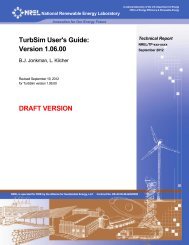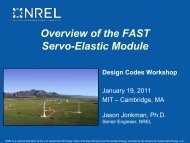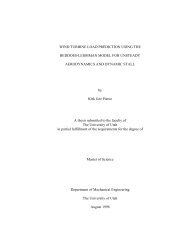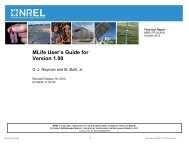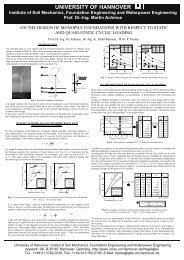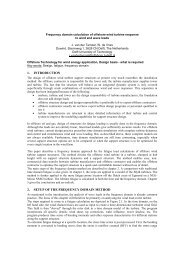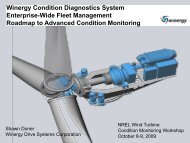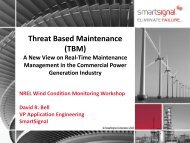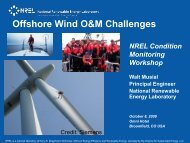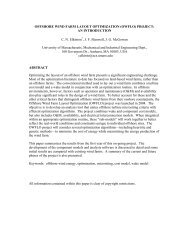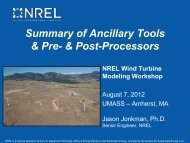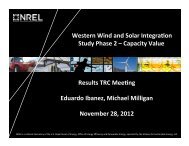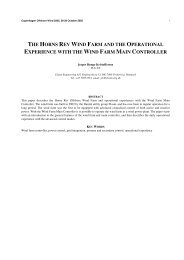NREL Wind Turbine Modeling Workshop
NREL Wind Turbine Modeling Workshop
NREL Wind Turbine Modeling Workshop
You also want an ePaper? Increase the reach of your titles
YUMPU automatically turns print PDFs into web optimized ePapers that Google loves.
Overview of the HydroDyn<br />
Hydrodynamics Module<br />
<strong>NREL</strong> <strong>Wind</strong> <strong>Turbine</strong><br />
<strong>Modeling</strong> <strong>Workshop</strong><br />
April 17, 2013<br />
JEMA – Tokyo, Japan<br />
Jason Jonkman, Ph.D.<br />
Senior Engineer, <strong>NREL</strong><br />
<strong>NREL</strong> is a national laboratory of the U.S. Department of Energy, Office of Energy Efficiency and Renewable Energy, operated by the Alliance for Sustainable Energy, LLC.
Outline<br />
<br />
<br />
<br />
<br />
<br />
<br />
Overview:<br />
– HydroDyn – What Is It?<br />
– Support Structure Types<br />
Monopiles:<br />
– Waves, Currents, & Hydrodynamic Loads<br />
Floating Platforms:<br />
– Waves, Currents, & Hydrodynamic Loads<br />
– Mooring Systems<br />
Recent Work<br />
Current & Planned Work<br />
Future Opportunities<br />
<strong>Wind</strong> <strong>Turbine</strong> <strong>Modeling</strong> <strong>Workshop</strong> 2 National Renewable Energy Laboratory
Overview<br />
HydroDyn – What Is It?<br />
<br />
<br />
Yet-to-be documented<br />
hydrodynamics routines for<br />
offshore wind turbines:<br />
– Currently an undocumented feature<br />
in FAST, A2AD, & SIMPACK<br />
– Input settings contained in FAST’s<br />
platform input file<br />
– Source code included in FAST<br />
v7.00.00a-bjj & newer<br />
– Interfaced to MSC.ADAMS via<br />
A2AD v13.00.00a-bjj & newer<br />
Theory Manual:<br />
– Jonkman Ph.D. Dissertation (2007)<br />
– Jonkman, <strong>Wind</strong> Energy (2009)<br />
<strong>Wind</strong> <strong>Turbine</strong> <strong>Modeling</strong> <strong>Workshop</strong> 3 National Renewable Energy Laboratory
Overview<br />
Support Structure Types<br />
<strong>Wind</strong> <strong>Turbine</strong> <strong>Modeling</strong> <strong>Workshop</strong> 4 National Renewable Energy Laboratory
Monopiles<br />
Waves, Currents, & Hydrodynamic Loads<br />
Wave kinematics:<br />
– Linear regular (periodic)<br />
– Linear irregular (stochastic):<br />
<br />
Pierson-Moskowitz, JONSWAP, or user-defined<br />
spectrum<br />
– With optional stretching:<br />
<br />
Vertical, extrapolation, or Wheeler<br />
– Arbitrary choice of wave direction, but no spreading<br />
– Or routine to read in externally generated wave data:<br />
<br />
Nonlinear wave option available<br />
Steady sea currents:<br />
– IEC-style sub-surface, near-surface, &<br />
depth-independent<br />
– Or user-defined<br />
Hydrodynamic loads:<br />
– Relative form of Morison’s equation<br />
– Calculated at each structural node along tower<br />
<strong>Wind</strong> <strong>Turbine</strong> <strong>Modeling</strong> <strong>Workshop</strong> 5 National Renewable Energy Laboratory
Floating Platforms<br />
Waves & Currents<br />
<br />
<br />
Wave kinematics:<br />
– Linear regular (periodic)<br />
– Linear irregular (stochastic):<br />
Pierson-Moskowitz, JONSWAP, or user-defined<br />
spectrum<br />
– Arbitrary choice of wave direction, but no<br />
spreading<br />
Steady sea currents:<br />
– IEC-style sub-surface, near-surface, & depthindependent<br />
– Or user-defined<br />
<strong>Wind</strong> <strong>Turbine</strong> <strong>Modeling</strong> <strong>Workshop</strong> 6 National Renewable Energy Laboratory
<strong>Wind</strong> <strong>Turbine</strong> <strong>Modeling</strong> <strong>Workshop</strong> 7 National Renewable Energy Laboratory<br />
<br />
Floating Platforms<br />
Hydrodynamic Loads<br />
Hydrodynamic loads:<br />
– Wave-body interaction with rigid platform<br />
– Arbitrary platform geometry<br />
– Linear frequency-domain radiation & diffraction<br />
solutions imported from WAMIT or equivalent:<br />
Internal frequency-to-time domain conversion<br />
– Radiation “memory effect” accounted for by<br />
direct time-domain convolution<br />
– Linear hydrostatic restoring<br />
– Applied as 6-component (lumped) load on<br />
platform at reference point<br />
– 2 nd -order (mean-drift, slow-drift, sumfrequency)<br />
effects neglected<br />
– Damping in surge, sway, roll, & pitch<br />
augmented with nonlinear viscous drag term<br />
from relative form of Morison’s equation:<br />
Distributed along platform analysis nodes
<strong>Wind</strong> <strong>Turbine</strong> <strong>Modeling</strong> <strong>Workshop</strong> 8 National Renewable Energy Laboratory<br />
Floating Platforms<br />
Hydrodynamics Calculation Procedure<br />
Platform<br />
Geometry<br />
Frequency-Domain Radiation / Diffraction<br />
Hydrodynamics Preprocessor (SWIM or WAMIT)<br />
Wave-Excitation Force<br />
(Diffraction Problem)<br />
Seed for<br />
RNG<br />
Wave Spectrum<br />
& Direction<br />
Sea<br />
Current<br />
Box-Muller<br />
Method<br />
White G aussian<br />
No ise<br />
Inverse FFT<br />
Incid ent-Wave<br />
Kin ematics<br />
Morison’s<br />
Equation<br />
Restoring Matrix<br />
(Hydrostatic Problem)<br />
Time-Domain Hydrodynamics (H ydroDyn)<br />
Buoyancy<br />
Calculation<br />
Buoy ancy<br />
Incident-Wave<br />
Excitation<br />
Viscous<br />
Drag<br />
Damping Matrix Added-Ma ss Matrix<br />
(Radiation Problem) (Radiation Problem)<br />
Cosine<br />
Transform<br />
Radiation Kernel<br />
Time<br />
Convolution<br />
Sum Forces<br />
Memory<br />
Effect<br />
Infinite-Freq.<br />
Limit<br />
Plat form<br />
Mot ions<br />
Hydrod ynamic<br />
For cing<br />
Lo ads<br />
Impu lsive<br />
Added Mass
<strong>Wind</strong> <strong>Turbine</strong> <strong>Modeling</strong> <strong>Workshop</strong> 9 National Renewable Energy Laboratory<br />
Floating Platforms<br />
Mooring Systems – Overview<br />
<br />
<br />
<br />
Continuous quasi-static mooring system<br />
module implemented within HydroDyn:<br />
– Solves nonlinear analytical catenary equations<br />
– Fairlead tensions applied as reaction forces on<br />
platform<br />
Accounts for:<br />
– Array of homogenous taut or catenary lines<br />
– Apparent weight of line in fluid<br />
– Elastic stretching<br />
– Seabed friction<br />
– Nonlinear geometric restoring<br />
Neglects:<br />
– Line bending stiffness<br />
– Mooring system inertia<br />
– Mooring system damping<br />
Dutch Tri-Floater
<strong>Wind</strong> <strong>Turbine</strong> <strong>Modeling</strong> <strong>Workshop</strong> 10 National Renewable Energy Laboratory<br />
Floating Platforms<br />
Mooring Systems – Calculation Procedure<br />
Mooring Lin e Properties<br />
( , , , )<br />
Quasi-Static Mooring-System Module (Calculations Shown for Each Line)<br />
Platform Position<br />
Global-to-Local<br />
Transformation<br />
Fairlead Location Relative<br />
to Anchor ( , )<br />
Newton-Raphson Iteration to<br />
Find Fairlead Tension<br />
Fairlead Tension ( , )<br />
Mooring Restoring<br />
Local-to-Global<br />
Transformation &<br />
Sum Tensions<br />
Compute Configuration of,<br />
& Tensions Within, Line<br />
Compute<br />
Anchor<br />
Tension<br />
Configu ration of,<br />
& Tensions Within, Line<br />
[ , , ]<br />
Anchor Tension<br />
( , )
Recent Work (all for FAST v8)<br />
<br />
<br />
<br />
Converted HydroDyn to the new<br />
modularization framework:<br />
– Standalone input file & source code<br />
Added linear state-space (SS)-based<br />
radiation formulation (with IST-Portugal):<br />
– Developed new SS_Fitting preprocessor for<br />
deriving SS models from WAMIT output<br />
through 4 system-identification approaches<br />
– Developed new HydroDyn submodule<br />
(SS_Rdtn), which uses the output from<br />
SS_Fitting, as an alternative to convolution<br />
Developed new multi-segmented quasistatic<br />
(MSQS) mooring system model<br />
t<br />
( ) ( ) ( )<br />
u y t = K t−τ u τ dτ<br />
y<br />
u<br />
∫<br />
0<br />
x<br />
= Ax + Bu<br />
y = Cx<br />
Reformulation of Radiation<br />
Convolution to Linear SS Form<br />
y<br />
Masciola et al. (2013)<br />
Example MSQS Mooring<br />
<strong>Wind</strong> <strong>Turbine</strong> <strong>Modeling</strong> <strong>Workshop</strong> 11 National Renewable Energy Laboratory
Recent Work (all for FAST v8) (cont)<br />
<br />
<br />
Extended HydroDyn to multi-member substructures:<br />
– Features:<br />
<br />
<br />
<br />
<br />
Multiple members & intersecting members at joints<br />
– Accurate calculation of overlap of intersecting members<br />
Inclined & tapered members<br />
Flooded & ballasted members<br />
Marine growth<br />
– Hydrodynamic loads:<br />
<br />
<br />
<br />
Distributed inertia, added mass, & viscous drag (Morison)<br />
Distributed static buoyancy & dynamic pressure<br />
Concentrated loads at member ends & joints<br />
– Applicable to:<br />
<br />
<br />
Fixed-bottom tripod or jacket substructures<br />
Thin members (e.g., braces/spokes) of floating platforms<br />
Developed new SubDyn module for multi-member<br />
substructure structural dynamics:<br />
– Linear frame FE<br />
– Craig-Bampton reduction<br />
Regular<br />
Member<br />
Super<br />
Member<br />
Jacket with<br />
Regular &<br />
Super Members<br />
<strong>Wind</strong> <strong>Turbine</strong> <strong>Modeling</strong> <strong>Workshop</strong> 12 National Renewable Energy Laboratory
<strong>Wind</strong> <strong>Turbine</strong> <strong>Modeling</strong> <strong>Workshop</strong> 13 National Renewable Energy Laboratory<br />
Current & Planned Work<br />
Interface updated HydroDyn & new<br />
SubDyn & MSQS modules into FAST v8<br />
Write HydroDyn, SubDyn, & MSQS user<br />
& theory manuals<br />
Further verify under IEA <strong>Wind</strong> Task 30<br />
(OC4)<br />
Verify recent FAST-OrcaFlex coupling<br />
Interface FAST to an MIT-developed<br />
module with nonlinear fluid-impulse theory<br />
Interface FAST to the TAMU-developed<br />
CHARM3D dynamic mooring code<br />
Interface ice-loading modules to FAST<br />
(with UMich & DNV)<br />
OC4 OC3
<strong>Wind</strong> <strong>Turbine</strong> <strong>Modeling</strong> <strong>Workshop</strong> 14 National Renewable Energy Laboratory<br />
Current & Planned Work (cont)<br />
<br />
<br />
Assess & add 2 nd -order<br />
hydrodynamic effects:<br />
– Add 2 nd -order irregular wave<br />
kinematics (with UT-Austin)<br />
– Assess magnitude of meandraft,<br />
slow-drift, & sumfrequency<br />
hydrodynamic loads<br />
for floaters (with ETH Zürich &<br />
CU-Boulder)<br />
– Add mean-drift, slow-drift, &<br />
sum-frequency hydrodynamic<br />
loads for floaters (with IST-<br />
Portugal)<br />
Add wave directional<br />
spreading (with IST-Portugal):<br />
– Both 1 st - & 2 nd order<br />
Agarwal (2008)<br />
Sea-Surface Elevation (η) from the Summing<br />
of 1 st - (η 1 ) & 2 nd - (η 2 ) Order Waves<br />
Multi-Directional Sea State
Current & Planned Work (cont)<br />
<br />
Calibrate & validate floating<br />
functionality through:<br />
– DeepCwind – 1:50 scale of 5-<br />
MW atop spar buoy, TLP, &<br />
semisubmersible<br />
– SWAY – 1:6.5 scale of 5-MW<br />
downwind turbine atop a TLS<br />
– <strong>Wind</strong>Float – Vestas V80 2-MW<br />
atop a PPI semisubmersible<br />
– Hywind – Siemens 2.3-MW<br />
atop Statoil spar buoy<br />
DeepCwind TLP<br />
SWAY<br />
<strong>Wind</strong>Float<br />
Hywind<br />
<strong>Wind</strong> <strong>Turbine</strong> <strong>Modeling</strong> <strong>Workshop</strong> 15 National Renewable Energy Laboratory
<strong>Wind</strong> <strong>Turbine</strong> <strong>Modeling</strong> <strong>Workshop</strong> 16 National Renewable Energy Laboratory<br />
Future Opportunities<br />
<br />
<br />
<br />
<br />
<br />
<br />
<br />
Develop a standalone dynamic<br />
mooring system module (MAP)<br />
Implement joint flexibility in<br />
SubDyn<br />
Extend wave stretching approach<br />
to multi-member structures<br />
Add nonlinear regular wave<br />
kinematics models for fixedbottom<br />
Add ability to prescribe wave time<br />
history for floaters<br />
Floating platform hydro-elastics<br />
Pressure mapping for floaters<br />
Applicability of Different<br />
Wave Theories
Questions?<br />
Jason Jonkman, Ph.D.<br />
+1 (303) 384 – 7026<br />
jason.jonkman@nrel.gov<br />
<strong>NREL</strong> is a national laboratory of the U.S. Department of Energy, Office of Energy Efficiency and Renewable Energy, operated by the Alliance for Sustainable Energy, LLC.



